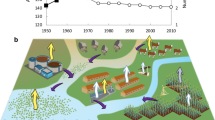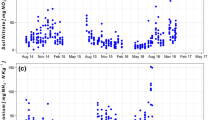Abstract
Humans seem to have doubled the global rate of terrestrial nitrogen fixation. Globally 50–70% (85 Tg, 1 Tg=1012 g) of the nitrogen supplied in fertilizer (80 Tg N/a) and leguminous crops (40–80 Tg N/a) are used to feed cattle. The aim of the present study was to derive some estimates of global N2O production from animal manure. As the parameter giving the most stable numerical basis for regional and global extrapolation we adopted the molar emission ratios of N2O to NH3. These ratios were measured in cattle, pig and chicken housings with different manure handling systems, in dung-heaps and in liquid manure storage tanks. Individual molar emission ratios from outside manure piles varied over two orders of magnitude, strongly dependent on the treatment of the manure. A median emission ratio of 1.6×10-2 (n=65) was obtained in cow-sheds with slatted floors and liquid manure stored underneath and a median ratio of 24×10-2 (n=31) was measured in a beef cattle housing with a solid manure handling system.
We next extrapolated to global NH3 emissions from those estimated for Europe, using N uptake by the animals as a scaling factor. Multiplication with observed N2O to NH3 ratios next provided some estimates of regional and global N2O emissions. To account for the great variability of the emission ratios of N2O/NH3, we developed upper and lower case emission scenarios, based on lower and upper quartiles of measured emission ratios. The global emission from cattle and swine manure is in the range of 0.2–2.5 Tg N-N2O/a, representing 44+-39% of the annual atmospheric accumulation rate. This N2O emission arises from about 40 Tg N/a of cattle and pig manure stored in or at animal housings. We did not account for N2O emissions from another 50 Tg N/a excreted by grazing cattle, goats and sheep, and application of the manure to agricultural fields. Our study makes it clear that major anthropogenic N2O emissions may well arise from animal manure. The large uncertainty of emission ratios, which we encountered, show that much more intense research efforts are necessary to determine the factors that influence N2O emissions from domestic animal manure both in order to derive a more reliable global estimate of N2O release and to propose alternative waste treatment methods causing smaller N2O releases. In our studies we found large enhancements in N2O releases when straw was added to the manure, which is a rather common practice. In view of the ongoing discussion in Europe to re-install the traditional solid manure system (bed down cattle) for environmental and animal welfare reasons, it is noteworthy that our measurements indicate highest N2O release from this particulary system.
In a similar manner, but based on a smaller data set, we also estimated the release of CH4 from cattle and swine manure and from liquid manure only to be about 9 Tg/year in good agreement with the estimate by the Environmental Protection Agency (1994) of 8.6+-2.6 Tg/year. A total annual methane release as high as 34 Tg/a was derived for solid and liquid cattle and pig manure from animals in housings.
Similar content being viewed by others
References
Asman, W. A. H., 1992: Ammonia emission in Europe: Updated emission and emission variations, Report No. 228 471 008, National Institute Of Public Health And Environmental Protection, Bilthoven, The Netherlands.
Beck, W. and Engelhardt, H., 1992: Capillary electrophoresis of organic and inorganic cations with indirect UV detection, Chromatographia 34(7/8), 313–316.
Berges, M. G. M., Hofmann, R. M., Scharffe, D., and Crutzen, P. J., 1992: Nitrous oxide emissions from motor vehicles in tunnels and their global extrapolation, J. Geophys. Res. 98(D10), 18527–18531.
Böttger, A., Ehhalt, D. H., and Gravenhorst, G., 1978: Atmosphärische Kreisläufe von Stickoxiden und Ammoniak, Berichte Kemforschungsanlage Jülich Nr. 1958.
Bouwman, A. F., Van derHoek, K. W., and Olivier, J. G. J., 1995: Uncertainties in the global source distribution of nitrous oxide, J. Geophys. Res. 100(D2), 2785–2800.
Brunke, E. G., Scheel, H. E., and Seiler, W., 1990. Trends of tropospheric CO, N2O and CH4 as observed at Cape Point, South Africa, Atmos. Environ. 24(A), 585–595, 1990.
Buijsman, E., Maas, H. F. M., and Asman, W. A. H., 1987: Anthropogenic NH3 emissions in Europe, Atmos. Environ. 25(5), 1009–1022.
Bundesministerium für Ernährung, Landwirtschaft und Forsten (Hrsg.), 1992: Statistisches Jahrbuch über Ernährung, Landwirtschaft und Forsten, Landwirtschaftsverlag Münster-Hiltrup.
Burton, D. L. and Beauchamp, E. G., 1986: Nitrogen loss from swine housings, Agricultural Wastes 15, 59–74.
Cicerone, R. J., Shetter, J. D., Stedman, D. H., Kelly, T. J., and Liu, S. C., 1978: Atmospheric N2O: Measurements to determine its sources, sinks and variations, J. Geophys. Res. 83(C6), 3042–3050.
Clar, U., 1991: Entwicklung einer Feldmethode zur Messung des Energieumsatzes bei Zugtieren, Dissertation am Institut für Tierproduktion, Universität Hohenheim, Germany.
Cofer, W. R., Collins, V. G., and Talbot, R. W., 1985: Improved aqueous scrubber for collection of soluble atmospheric trace gases, Environ. Sci. Technol. 19, 557–560.
Crutzen, P. J., Aselmann, I., and Seiler, W.: 1986, Methane production by domestic animals, wild ruminants, other herbivorous fauna, and humans, Tellus 38B, 271–284.
Crutzen, P. J., 1971: Ozone production rates in an oxygen-hydrogen-nitrogen oxide atmosphere, J. Geophys. Res. 76, 7311–7327.
Crutzen, P. J., 1970: The influence of nitrogen oxides on the atmospheric ozone content, Q. J. R. Meteorol. Soc. 96, 320–325.
Dentener, F. J. and Crutzen, P. J., 1994: A three-dimensional model of the global ammonia cycle, J. Atmos. Chem. 19, 331–369.
European Centre for Ecotoxicology and Toxicology of Chemicals (ECETOC), 1994: Technical report 62, Ammonia emissions to air in Western Europe, Brussels, Belgium.
Enquete-Kommission ‘Schutz der Erdatmosphäre’, 1994: 3. Bericht ‘Schutz der Grünen Erde’, Economica-Verlag, Bonn, Germany.
Environmental Protection Agency (EPA), 1990: Recommended operating procedure no. 45: Analysis of nitrous oxide from combustion sources, EPA Rep. 600/8-90-053, Washington D.C.
Environmental Protection Agency (EPA), 1994: International anthropogenic methane emissions: Estimates for 1990, report to congress, M. J. Adler (ed.), EPA 230-R-93-010.
Food and Agriculture Organization of the United Nations (FAO), 1990: Fertilizer Yearbook Vol. 39, FAO statistics series No. 95, FAO Rome.
Food and Agriculture Organization of the United Nations (FAO), 1993: Production Yearbook Vol. 46, 1992, Rome.
Golueke, C. C., 1972: Composting—a Study of the Process and its Principles, Rodale Press, Emmaus Pa., U.S.A.
Granz, E., 1985: Tierproduktion, 10. Aufl., Verlag Paul Parey, Berlin und Hamburg.
Hardy, R. W. F. and Havelka, U. D., 1975: Nitrogen fixation research: A key to world food? Science 188, 633–643.
Hartung, J., 1992: Emission und Kontrolle von Gasen und Geruchsstoffen aus Ställen und Dunglagern, Zbl. Hyg. 192, 389–418.
Helfferich, B. and Gütte, J. O., 1972: Tierernährung in Stichworten, Verlag Ferdinand Hirt.
Intergovermental Panel on Climate Change (IPCC), 1992: Climate change, in: J. T.Houghton, B. A.Callander, and S. K.Varney (eds), The Supplementary Report to the IPCC Scientific Assessment, Cambridge University Press, New York.
Intergovermental Panel on Climate Change (IPCC), 1995: Climate change 1994, J. T.Houghton, L. G.Meira Filho, J.Bruce, HoesungLee, B. A.Callander, E.Haites, N.Harris, and K.Maskell (eds), Cambridge University Press, New York.
Isermann, K., 1994: Ammoniak, in Enquete-Kommission ‘Schutz der Erdatmosphäre’ (Hrsg.), Landwirtschaft, Studienprogramm, Economica-Verlag, Bonn.
Jaffe, D. A., 1992: The nitrogen cycle, in: S. S.Butcher et al. (eds), Global Biogeochemical Cycles, Academic Press, London.
Jilg, T., 1986: Zur Wirkung verschiedener Sojaprodukte auf die Stickstoff-und Energiebilanz bei Hochleistungskühen, Dissertationsschrift an der Fakultät IV-Agrawissenschaften II der Universität Hohenheim.
Junge, C. E., 1956: Recent investigations in air chemistry, Tellus 8, 127–139.
Khalil, M. A. K. and Rasmussen, R. A., 1988: Nitrous oxide: Trends and global mass balance over the last 3000 years, Ann. Glaciol. 10, 73–79.
Khalil, M. A. K. and Rasmussen, R. A., 1992: The global sources of nitrous oxide, J. Geophys. Res. 97(D13), 14,651–14,660.
Kinzig, A. P. and Socolow, R. H., 1994: Human impacts on the nitrogen cycle, Physics Today, November, 24–31.
Kirchgessner, M., 1985: Tierernährung, 6. Aufl., DLG-Verlag, Frankfurt (M).
Kolenbrander, G. J., 1954: Die Verluste an organischer Substanz im Stalldünger, Z. Pflanzenernähr., Düng., Bodenkunde 69(1–3), 125–134.
Koriath, E., 1975: Güllewirtschaft-Gülledüngung, VEB Deutscher Landwirtschaftsverlag, Berlin.
Leuenberger, M. and Siegenthaler, U., 1992: Ice-age atmospheric concentrations of nitrous oxide from an Antarctic ice-core, Nature, 360, 449–451.
Lieth, H., 1975: Measurements of calorific values, in H.Lieth and R. H.Whittaker (eds), Primary Productivity of the Biosphere, Springer, New York, Heidelberg, Berlin.
McElroy, M. B. and McConnell, J. C., 1971: Nitrous oxide: A natural source of stratospheric NO, J. Atmos. Sci. 28, 1095–1098.
Menzi, H. and Besson, J. M., 1992: Differenzierte Richtwerte über Anfall und Zusammensetzung von Mist und Gülle als Hilfsmittel für die optimale Verwertung von Hofdünger, VFLUFA-Schriftenreihe 35. Kongreßband, 222–225, Göttingen.
Minson, D. J., 1993: Methane production by sheep and cattle in Australia, Tellus 45B, 86–88.
Mitra, A. P., 1992: Greenhouse gas emissions in India (1992 Update), CSIR, New Delhi-110012.
Möller, D. and Schieferdecker, H. 1989: Ammonia emission and deposition of NHx in the GDR, Atmos. Environ. 23(6), 1187–1193.
Mulhall, M. G., 1892: The Dictionary of Statistics, G. Routledge and Sons, London, pp. 108–110.
Nevison, C., 1994: A model analysis of the spatial distribution and temporal trends of nitrous oxide sources and sinks, National Center for Atmospheric Research, Boulder, Cooperative Thesis No. 147.
Prinn, R., Cunnold, D., Rasmussen, R., Simmonds, P., Alyea, F., Crawford, A., Fraser, P., and Rosen, R., 1990: Atmospheric emissions and trends of nitrous oxide deduced from 10 years of ALEGAGE data, J. Geophys. Res. 95(D11), 18,369–18,385, 1990.
Sauerlandt, W. and Tietjen, C., 1970: Humuswirtschaft des Ackerbaues, DLG-Verlag Frankfurt/Main.
Schade, G. W. and Crutzen, P. J., 1995: Emissions of aliphatic amines from animal husbandry and their reactions: Potential source of N2O and HCN, J. Atmos. Chem. 22, 319–346.
Schlesinger, W. H., 1991. Biogeochemistry: An Analysis of Global Change, Academic Press, San Diego.
Sibbesen, E. and Lind, A. M., 1993: Loss of nitrous oxide from animal manure in dungheaps, Acta Agric. Scand., Sect. B, Soil and Plant Sci. 43, 16–20.
Sommer, S., Klausen, P. S., Christensen, B. T., Hansen, J., Jensen, N., and Olsen, H., 1984: Calculation of the ammonia volatilization from animal manure in Denmark, Miljoministeriet, Center for Jorkokologi, Soborg, Denmark.
Strauch, D., 1987. Animal Production and Environmental Health, World Animal Science, B6, Elsevier, Amsterdam.
Söderlund, R. and Svensson, B. H., 1975: The global nitrogen cycle, in Nitrogen, Phosphorus and Sulphur-Global Cycles. SCOPE Report 7. Ecol. Bull. 22: 23–73, Stockholm.
VanVuuren, H. G. and Meijs, J. A. C., 1987: Manure as a source of nitrogen and phosphorus in soils, in: Animal Manure on Grassland and Fodder Crops, Fertilizer or Waste?. Martinus Nijhoff Publishers Dordrecht, Boston, Lancaster, pp. 17–26.
Vanderholm, D. H., 1975: Nutrient losses from livestock waste during storage, treatment and handling, in: Managing Livestock Wastes, Am. Soc. Agric. Eng., St. Joseph, Michigan, U.S.A.
Wendland, F., Albert, H., Bach, M., and Schmidt, R. (eds), 1993: Atlas zum Nitratstrom in der Bundesrepublik Deutschland, Springer-Verlag Berlin Heidelberg.
Yoshinari, T., 1980: N2O Reduction by Vibrio succinigenes, Appl. Environ. Microbiol., 81–84.
Zardini, D., Raynaud, D., Scharffe, D., and Seiler, W., 1989: N2O measurements of air extracted from Antartic ice cores: Implications on atmospheric N2O back to the last glacial-interglacial transition, J. Atmos. Chem. 8, 189–201.
Author information
Authors and Affiliations
Rights and permissions
About this article
Cite this article
Berges, M.G.M., Crutzen, P.J. Estimates of global N2O emissions from cattle, pig and chicken manure, including a discussion of CH4 emissions. J Atmos Chem 24, 241–269 (1996). https://doi.org/10.1007/BF00210285
Received:
Revised:
Issue Date:
DOI: https://doi.org/10.1007/BF00210285




